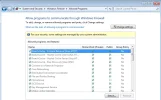You could also use your Router admin utility to block inbound or outbound traffic by type, such as TCP or UDP packets. Setting up rules this way or by using a good software firewall such as provided with most Internet Security software suites such as Norton, McAfee, or Avast though most of those are app-centered rules. Businesses typically use router-based packet-filtering instead of relying on app-based packet filtering which is unexact. Additionally, they will install Packet-Filtering appliances costing thousands of dollars such as Cisco-PIX or RADIUS boxes on the TDC of their Intranet or Extranet (especially if they are running Web-hosting servers) to manage the high volumes of traffic and ensuing packet traffic going in/out of their network. Packet-filtering then is a much finer tool, like a surgeon using a fiber-optic camera to repair arteries in the heart or brain as opposed to a hacksaw. Over-exaggerating a bit, but you get the point. You are attempting to do your packet-filtering with a hacksaw instead of a micro-tool/camera.

I suggest you look at the packet-filtering capabilities of your router (download your owner's manual). If you are not using a router, but have your computer directly connected to your ISP-provided Cable Modem or DSL Modem;
most of the ISPs don't let you have access to their boxes, since they are premises leased equipment which you don't own, and they are responsible for. If this is your situation, I might suggest you purchase a quality router (Cisco/Linksys or Netgear) and use the built-in packet-filtering capabilities to filter your packet traffic the way you want it, not the way Microsoft wants you to do it using their app-based filtering.

Expect this to take some time, as this type of packet-filtering at the router (or security appliance) requires expert networking skills which are not acquired overnight. It takes years to understand how all of this works, but if you're willing to delve into it you can achieve a much more precise control of what comes into your computer and what goes out of it (upload). If this isn't your cup of tea, there are softwares that can help you to do this, and personally these app-bases rules you are using doesn't keep out many modern viruses/malware as the hackers have studied this information and know how to bypass it rather easily. (there are viruses now which can switch off your app-bases rules, and worse yet completely remove your AV from your computer!

). You would be better served to look at other protection techniques so as replacing your Hosts file with an alias file. Don't know if that's your primary reason for using traffic rules or not, but that's what most users use them for.
My 2 cents.
Best of luck,
 <<<BIGBEARJEDI>>>
<<<BIGBEARJEDI>>>



 I suggest you look at the packet-filtering capabilities of your router (download your owner's manual). If you are not using a router, but have your computer directly connected to your ISP-provided Cable Modem or DSL Modem;
I suggest you look at the packet-filtering capabilities of your router (download your owner's manual). If you are not using a router, but have your computer directly connected to your ISP-provided Cable Modem or DSL Modem; 
